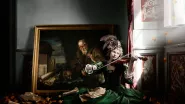The relationship between sex and food is long-standing, with obvious metaphoric similarities between certain kinds of food and sexual organs, as well as the similar sensuous pleasures that the body experiences through touch, smell, and taste. Fruits are indeed a well-fitting example, nowadays more and more exposed to a certain kind of pornography. In Western culture, the equation between sex and food has often been represented to women as a form of desire, with portraits advertising the pleasures of eating as sexually satisfying long before the term “gastro-porn” started to be spread. Coming from advertising photography, this malicious association has become a common practice in art photography too.
The sexual metaphor of food is pleasurable when looking at a picture, but it hides an aspect of intense frustration: on one hand, imagery encourages an indulgent and cunning body, and on the other something unresolved for the artists themselves. Indeed for many women in arts, these images set up a range of obsessions regarding temptation, hunger, anxiety, and a lack of self-confidence. They indulge the desire of the “reader” who looks at the pictures, and longs to be taken into account and to be wanted or desired, engaging erotically with femininity.
Narratives of luxury and seduction, carnal and abject desires though the representation of food can be considered a way of making pornography out of the body and genitals. Pornography is itself naive, finding its meaning in the pure exposition of sex, with no strings attached. Lifeless genitalia lost their ancestral nature, and so women become the inessential, the object, the unreal, or the symbolic sex. Thus, images and sex symbols are encouraged to proliferate, but the reality of women is characterized as boring, ugly, or perverse and is tabooed.
It’s not that metaphors and elusive representations should be banned, as long as delicacy creates an atmosphere of dignity. Silvia Bigi (@silvia__bigi)’s The Blood and the Milk work is simply what best represents the concept of “ethic of delicacy”. This work refers to the expression lisi i tâmlit (the Tree of milk), taken from the Lek Dukagjini’s Kanun, an ancient code of laws and precepts established down the centuries in the mountain areas of Albany. The female lineage is so defined as the Tree of milk, in opposition to the Tree of blood, which is the masculine ancestry, the dominant one as in every patriarchal society.
© Silvia Bigi
In the photographic progression made by Silvia Bigi, the two opposites elements, milk, and blood, unite. The ambiguity of blood - symbolizing power, brotherhood, lineage, and at the same time feminine fertility and birth - is mixed with milk, which is nourishment, growth, caregiving, abundance, and male fertility. The ancestral wound that separates the two natures is meant to be resolved within this new unity, also overcoming the common view of men as the active and dominant part of the couple.
Not perverse, ugly, or boring, the reality of women is represented here as consistent and compelling, and her innate nature is taken back. Milk is indeed a metaphor for fertility, at is best intended as a connotation of self-empowerment and consciousness of the vital force of the body. Here’s where the ethic of delicacy lays, where food is not a mere objectification or “fetishism” but a symbol requiring deep understandings of its nature.






